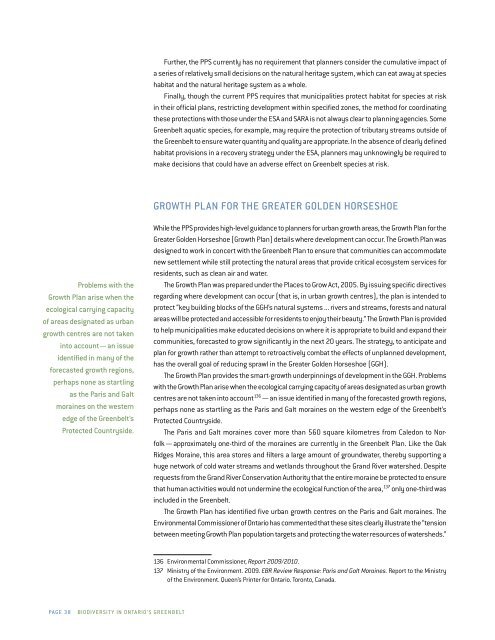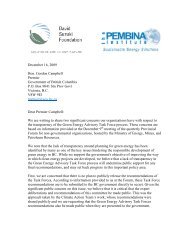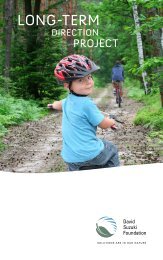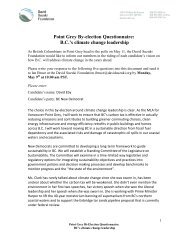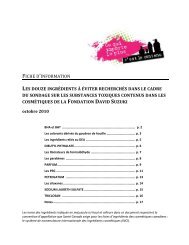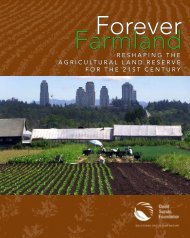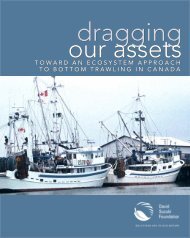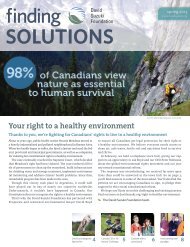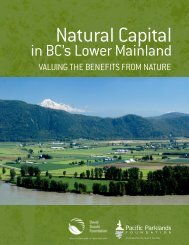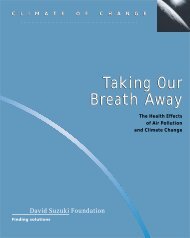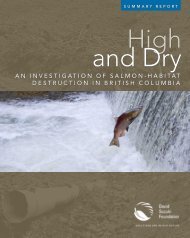Biodiversity in Ontario's Greenbelt (PDF) - David Suzuki Foundation
Biodiversity in Ontario's Greenbelt (PDF) - David Suzuki Foundation
Biodiversity in Ontario's Greenbelt (PDF) - David Suzuki Foundation
You also want an ePaper? Increase the reach of your titles
YUMPU automatically turns print PDFs into web optimized ePapers that Google loves.
Further, the PPS currently has no requirement that planners consider the cumulative impact of<br />
a series of relatively small decisions on the natural heritage system, which can eat away at species<br />
habitat and the natural heritage system as a whole.<br />
F<strong>in</strong>ally, though the current PPS requires that municipalities protect habitat for species at risk<br />
<strong>in</strong> their official plans, restrict<strong>in</strong>g development with<strong>in</strong> specified zones, the method for coord<strong>in</strong>at<strong>in</strong>g<br />
these protections with those under the ESA and SARA is not always clear to plann<strong>in</strong>g agencies. Some<br />
<strong>Greenbelt</strong> aquatic species, for example, may require the protection of tributary streams outside of<br />
the <strong>Greenbelt</strong> to ensure water quantity and quality are appropriate. In the absence of clearly def<strong>in</strong>ed<br />
habitat provisions <strong>in</strong> a recovery strategy under the ESA, planners may unknow<strong>in</strong>gly be required to<br />
make decisions that could have an adverse effect on <strong>Greenbelt</strong> species at risk.<br />
Growth Plan for the Greater Golden Horseshoe<br />
Problems with the<br />
Growth Plan arise when the<br />
ecological carry<strong>in</strong>g capacity<br />
of areas designated as urban<br />
growth centres are not taken<br />
<strong>in</strong>to account — an issue<br />
identified <strong>in</strong> many of the<br />
forecasted growth regions,<br />
perhaps none as startl<strong>in</strong>g<br />
as the Paris and Galt<br />
mora<strong>in</strong>es on the western<br />
edge of the <strong>Greenbelt</strong>’s<br />
Protected Countryside.<br />
While the PPS provides high-level guidance to planners for urban growth areas, the Growth Plan for the<br />
Greater Golden Horseshoe (Growth Plan) details where development can occur. The Growth Plan was<br />
designed to work <strong>in</strong> concert with the <strong>Greenbelt</strong> Plan to ensure that communities can accommodate<br />
new settlement while still protect<strong>in</strong>g the natural areas that provide critical ecosystem services for<br />
residents, such as clean air and water.<br />
The Growth Plan was prepared under the Places to Grow Act, 2005. By issu<strong>in</strong>g specific directives<br />
regard<strong>in</strong>g where development can occur (that is, <strong>in</strong> urban growth centres), the plan is <strong>in</strong>tended to<br />
protect “key build<strong>in</strong>g blocks of the GGH’s natural systems ... rivers and streams, forests and natural<br />
areas will be protected and accessible for residents to enjoy their beauty.” The Growth Plan is provided<br />
to help municipalities make educated decisions on where it is appropriate to build and expand their<br />
communities, forecasted to grow significantly <strong>in</strong> the next 20 years. The strategy, to anticipate and<br />
plan for growth rather than attempt to retroactively combat the effects of unplanned development,<br />
has the overall goal of reduc<strong>in</strong>g sprawl <strong>in</strong> the Greater Golden Horseshoe (GGH).<br />
The Growth Plan provides the smart-growth underp<strong>in</strong>n<strong>in</strong>gs of development <strong>in</strong> the GGH. Problems<br />
with the Growth Plan arise when the ecological carry<strong>in</strong>g capacity of areas designated as urban growth<br />
centres are not taken <strong>in</strong>to account 136 — an issue identified <strong>in</strong> many of the forecasted growth regions,<br />
perhaps none as startl<strong>in</strong>g as the Paris and Galt mora<strong>in</strong>es on the western edge of the <strong>Greenbelt</strong>’s<br />
Protected Countryside.<br />
The Paris and Galt mora<strong>in</strong>es cover more than 560 square kilometres from Caledon to Norfolk<br />
— approximately one-third of the mora<strong>in</strong>es are currently <strong>in</strong> the <strong>Greenbelt</strong> Plan. Like the Oak<br />
Ridges Mora<strong>in</strong>e, this area stores and filters a large amount of groundwater, thereby support<strong>in</strong>g a<br />
huge network of cold water streams and wetlands throughout the Grand River watershed. Despite<br />
requests from the Grand River Conservation Authority that the entire mora<strong>in</strong>e be protected to ensure<br />
that human activities would not underm<strong>in</strong>e the ecological function of the area, 137 only one-third was<br />
<strong>in</strong>cluded <strong>in</strong> the <strong>Greenbelt</strong>.<br />
The Growth Plan has identified five urban growth centres on the Paris and Galt mora<strong>in</strong>es. The<br />
Environmental Commissioner of Ontario has commented that these sites clearly illustrate the “tension<br />
between meet<strong>in</strong>g Growth Plan population targets and protect<strong>in</strong>g the water resources of watersheds.”<br />
136 Environmental Commissioner, Report 2009/2010.<br />
137 M<strong>in</strong>istry of the Environment. 2009. EBR Review Response: Paris and Galt Mora<strong>in</strong>es. Report to the M<strong>in</strong>istry<br />
of the Environment. Queen’s Pr<strong>in</strong>ter for Ontario. Toronto, Canada.<br />
Page 38<br />
<strong>Biodiversity</strong> <strong>in</strong> Ontario’s greenbelt


